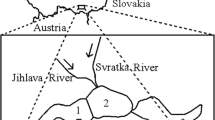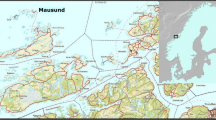Abstract
Purpose
This paper analyses the presence of polychlorinated biphenyls (PCBs) in escaped: farmed and wild salmons in southern Chile, analysing their concentrations and congener profiles in two species (Oncorhynchus kisutch and Oncorhynchus mykiss).
Methods
Muscle samples from both farmed and escaped fish of two species, O. mykiss (rainbow trout) and O. kisutch (coho salmon), were analysed for PCBs (42 congeners). To differentiate between the wild salmon and the salmon that have escaped from fish farms, the astaxanthin content in the muscular tissue was analysed with a high-performance liquid chromatography -diode array detector method. PCBs were measured by gas chromatography with an electron capture detector.
Results
The levels of astaxanthin can be used to differentiate between farmed, escaped and wild-borne salmons with statistically different concentrations. When comparing the total PCB concentrations for both trout and salmon samples, it can be determined that a separate analysis for farmed, escaped and wild-borne fish more accurately describes the real differences in the concentrations; these differences are hidden when separate analyses are not performed. The congener profiles are similar in both trout and coho salmon, where the tri-, tetra- and penta-CB congeners are the most abundant.
Conclusion
This study is the first report of PCBs in wild-borne, farmed and escaped salmons for the Southern Hemisphere, considering that Chile is actually one of the principal world producers of salmon.




Similar content being viewed by others
References
Berdié L, Grimalt JO (1998) Assessment of the sample handling procedures in a labor-saving method for the analysis of organochlorine compounds in a large number of fish samples. J Chromatogr A 823:373–380
Blais J, Charpentié S, Pick F, Kimpe L, Amand A, Regnault-Roge C (2006) Mercury, polybrominated diphenyl ether, organochlorine pesticide, and polychlorinated biphenyl concentrations in fish from lakes along an elevation transect in the French Pyrénées. Ecotox Environ Saf 63:91–99
Blanc J, Choubert G (1985) Genetic variation of flesh colour in cantaxanthin fed rainbow trout. Genet Sel Evol 17:243–250
Brooks B, Riley T, Taylor R (2006) Water quality of effluent dominated ecosystems: ecotoxicological, hydrological, and management considerations. Hydrobiologia 556:365–379
Carson D, Hites R (2005) Polychlorinated biphenyls in salmon and salmon feed: global differences and bioaccumulation. Environ Sci Technol 39:7389–7395
Christiansen R, Struknaes G, Estermann R, Torrissen O (1995) Assessment of flesh colour in Atlantic salmon. Salmo salar L Aquacult Res 26:311–322
Darnerud O, Atuma S, Aune M, Bjerselius R, Glynn A, Petersson Grawe K, Becker W (2006) Dietary intake estimations of organohalogen contaminants (dioxins, PCB, PBDE and chlorinated pesticides, e.g. DDT) based on Swedish market basket data. Food Chem Toxicol 44:1597–1606
Easton M, Luszniak D, Von der Geest E (2002) Preliminary examination of contaminant loadings in farmed salmon, wild salmon and commercial salmon feed. Chemosphere 46:1053–1074
Ewald G, Larsson P, Linge H, Okla L, Szarzi N (1998) Biotransport of organic pollutants to an inland Alaska lake by migrating sockeye salmon (Oncorhynchus nerka). Arctic 51(1):40–47
FAO (2004) The state of world fisheries and aquaculture: 2004. FAO, Rome. Also available at ftp://ftp.fao.org/docrep/fao/007/y5600e/y5600e00.pdf
Faroon O, Jones D, De Rosa C (2000) Effects of polychlorinated biphenyls on the nervous system. Toxicol Ind Health 16:305–333
Groot C, Margolis L (1991) Pacific salmon life histories. UBC, Vancouver
Hayward D, Wong J, Krynitsky A (2007) Polybrominated diphenyl ethers and polychlorinated biphenyls in commercially wild caught and farm-raised fish fillets in the United States. Environ Res 103:46–54
Hites R, Foran J, Carpenter D, Hamilton M, Knuth B, Schwager S (2004) Global assessment of organic contaminants in farmed salmon. Science 303:226–229
Ikonomou M, Higgs D, Gibbs M, Oakes J, Skura B, Mckinley S, Balfry S, Jones S, Withler R, Dubetz C (2007) Flesh Quality of Market-Size Farmed and Wild British Columbia Salmon. Environ Sci Technol 41:437–443
Isosaari P, Vartiainen T, Hallikainen A, Ruohonen K (2002) Feeding trial on rainbow trout: comparison of dry fish feed and Baltic herring as a source of PCDD/Fs and PCBs. Chemosphere 48:795–804
Jackson L, Carpenter S, Manchester-Neesving J, Stow C (2001) PCB Congeners in Lake Michigan coho (Oncorhynchus kisutch) and chinook (Oncorhynchus tshawytscha) Salmon. Environ Sci Technol 35:856–862
Kiviranta H, Ovaskainenb M, Vartiaine T (2004) Market basket study on dietary intake of PCDD/Fs, PCBs, and PBDEs in Finland. Environ Int 30:923–932
Little A, Martinsen C, Sceurman L (1979) Colour assessment of experimentally pigmented rainbow trout. Colour Res Appl 4:92–95
Manchester-Neesving J, Valters K, Sonzogni W (2001) Comparison of polybrominated diphenyl ethers (PBDEs) and polychlorinated biphenyls (PCBs) in Lake Michigan salmons. Environ Sci Technol 35:1072–1077
Madenjian C, Elliott R, Schmidt L, Desorcie T, Hesselberg R, Quintal R, Begnoche L, Bouchard P, Holey M (1998a) Net trophic transfer efficiency of PCBs to Lake Michigan coho salmon from their prey. Environ Sci Technol 32:3063–3067
Madenjian C, Hesselberg R, DeSorcie T, Schmidt L, Stedman R, Quintal R, Begnoche L, Passino-Reader D (1998b) Estimate of net trophic transfer efficiency of PCBs to Lake Michigan Lake trout from their prey. Environ Sci Technol 32:886–891
Mendoza G, Gutierrez L, Pozo-Gallardo K, Fuentes-Rios D, Montory M, Urrutia R, Barra R (2006) Polychlorinated biphenyls (PCBs) in mussels along the Chilean Coast. Environ Sci Pollut Res 13:67–74
Montory M, Barra R (2006) Preliminary data on polybrominated diphenyl ethers (PBDEs) in farmed fish tissues (Salmo salar) and fish feed in Southern Chile. Chemosphere 63:1252–1260
Montory M, Habit E, Fernandez P, Grimalt JO, Barra R (2010) PCBs and PBDEs in wild chinook salmon (Oncorhynchus tshawytscha) in the Northern Patagonia, Chile. Chemosphere 78:1193–1199
Naiman R, Bilby R, Schindler D, Helfield J (2002) Pacific salmon, nutrients, and the dynamics of freshwater and riparian ecosystems. Ecosystems 5:399–417
O’Neill S, West J, Hoeman J (1998) Spatial trends in the concentration of polychlorinated biphenyls (PCBs) in chinook (Oncorhynchus tshawytscha) and coho salmon (O. kisutch) in Puget sound and factors affecting PCB accumulation: results from the puget sound ambient monitoring program. In: Puget Sound Research Proceedings. Puget Sound Water Quality Action Team, Seattle, WA, USA, pp 312–328
Page G, Davies S (2006) Tissue astaxanthin and canthaxanthin distribution in rainbow trout (Oncorhynchus mykiss) and Atlantic salmon (Salmo salar). Comp Biochem Phys A 143:125–132
Pozo K, Urrutia R, Barra R, Mariottini M, Treutler HC, Araneda A, Focardi S (2007) Records of polychlorinated biphenyls (PCBs) in sediments of four remote Chilean Andean Lakes. Chemosphere 66:1911–1921
Salmonchile (2008) Ficha industria del salmón (n 1/2008). http://www.salmochile.cl
Sepúlveda M, Farias F, Soto E (2009) Salmon escapes in Chile. Incidents, impacts, mitigation and prevention. WWF, Valdivia
Shaw U, Brenner D, Berger M, Carpenter D, Hong C, Kannan K (2006) PCBs, PCDD/Fs, and organochlorine pesticides in farmed Atlantic salmon from Maine, Eastern Canada, and Norway, and wild salmon from Alaska. Environ Sci Technol 40:5347–5354
Soto D, Jara F, Moreno C (2001) Escaped salmon in the inner seas, southern Chile: facing ecological and social conflicts. Ecol Appl 11:1750–1762
Storebakken T, Foss P, Schiedt K, Aüstreng E, Liaaen-Jensen S, Manz U (1987) Carotenoids in diets for salmonids: IV. Pigmentation of Atlantic salmon with astaxanthin, astastaxanthin dipalmitate and cantaxanthin. Aquaculture 51:245–255
Torrissen O, Naevdal G (1984) Pigmentation of salmonids: genetical variation in carotenoids deposition in rainbow trout. Aquaculture 18:59–66
Torrissen O, Struknaes C, Estermann R (1995) Astaxanthin deposition in the flesh of Atlantic salmon, Salmo salar L. in relation to dietary astaxanthin concentration and feeding period. Aquacult Nutr 1:77–84
UNEP (2002) PCB transformers and capacitors from management to reclassification and disposal. Available from http://www.chem.unep.ch/Pops/pdf/ PCBtranscap.pdf
UNESCO (1995) http://www.unesco.com
Van Leeuwen S, Van Velzen M, Swart C, Van der Veen I, Traag W, de Boer J (2009) Halogenated contaminants in farmed salmon, trout, tilapia, pangasius, and shrimp. Environ Sci Technol 43:1379–1385
Vives I, Grimalt J, Catalan J, Rosseland B, Battarbee R (2004) Influence of altitude and age in the accumulation of organochlorine compounds in fish from High Mountain Lakes. Environ Sci Technol 38:690–698
Vizcaino E, Arellano L, Fernandez P, Grimalt JO (2009) Analysis of whole congener mixtures of polybromodiphenyl ethers by gas chromatography–mass spectrometry in both environmental and biological samples at femtogram levels. J Chromatogr A 1216:5045–5051
Acknowledgments
This work was supported by FONDECYT no. 1080294 (R Barra, E Habit), the Centre for Ecosystem Research of Patagonia (CIEP), and partially by FONDECYT no. 1080082 (E. Habit).
Author information
Authors and Affiliations
Corresponding author
Additional information
Responsible editor: Ake Bergman
Rights and permissions
About this article
Cite this article
Montory, M., Habit, E., Bahamonde, P. et al. Polychlorinated biphenyls in farmed and wild Onchorhynchus kisutch and Onchorhynchus mykiss from the Chilean Patagonia. Environ Sci Pollut Res 18, 629–637 (2011). https://doi.org/10.1007/s11356-010-0408-x
Received:
Accepted:
Published:
Issue Date:
DOI: https://doi.org/10.1007/s11356-010-0408-x




